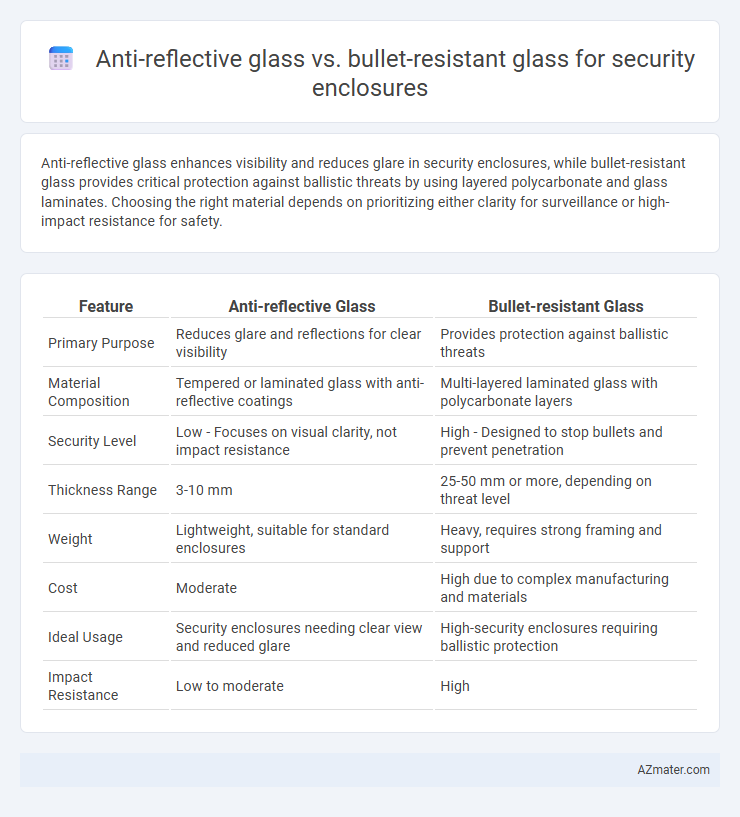Anti-reflective glass enhances visibility and reduces glare in security enclosures, while bullet-resistant glass provides critical protection against ballistic threats by using layered polycarbonate and glass laminates. Choosing the right material depends on prioritizing either clarity for surveillance or high-impact resistance for safety.
Table of Comparison
| Feature | Anti-reflective Glass | Bullet-resistant Glass |
|---|---|---|
| Primary Purpose | Reduces glare and reflections for clear visibility | Provides protection against ballistic threats |
| Material Composition | Tempered or laminated glass with anti-reflective coatings | Multi-layered laminated glass with polycarbonate layers |
| Security Level | Low - Focuses on visual clarity, not impact resistance | High - Designed to stop bullets and prevent penetration |
| Thickness Range | 3-10 mm | 25-50 mm or more, depending on threat level |
| Weight | Lightweight, suitable for standard enclosures | Heavy, requires strong framing and support |
| Cost | Moderate | High due to complex manufacturing and materials |
| Ideal Usage | Security enclosures needing clear view and reduced glare | High-security enclosures requiring ballistic protection |
| Impact Resistance | Low to moderate | High |
Introduction to Security Glass Solutions
Security glass solutions include Anti-reflective glass and Bullet-resistant glass, each designed to enhance visibility and protection in security enclosures. Anti-reflective glass reduces glare and improves transparency, ensuring clear monitoring and communication, while Bullet-resistant glass provides impact resistance and ballistic protection to safeguard personnel and assets. Choosing the appropriate glass depends on the specific security requirements, balancing visibility needs with threat levels.
Understanding Anti-reflective Glass
Anti-reflective glass enhances visibility by minimizing glare and reflections, making it ideal for security enclosures where clear observation is crucial. Its multilayer coating reduces light reflection to less than 1%, improving transparency and ensuring accurate monitoring without compromising aesthetics. This glass type supports unobstructed communication and interaction while maintaining safety standards in environments requiring vigilance.
What is Bullet-resistant Glass?
Bullet-resistant glass, also known as ballistic glass, is a laminated material designed to withstand and absorb the impact of bullets, providing critical protection in security enclosures such as banks, government buildings, and armored vehicles. Unlike anti-reflective glass, which primarily reduces glare and improves visibility, bullet-resistant glass consists of multiple layers of laminated glass and polycarbonate to prevent penetration and ensure occupant safety. Its thickness and material composition vary depending on the level of threat resistance required, adhering to standardized testing protocols such as UL 752 or EN 1063.
Key Properties: Transparency and Clarity
Anti-reflective glass offers superior transparency and clarity by minimizing glare and reflections, making it ideal for security enclosures where visual accuracy is critical. Bullet-resistant glass, while providing essential protection against ballistic threats, often features multiple layers that can slightly reduce optical clarity and transparency compared to standard glass. Selecting between these materials involves balancing the need for clear visibility with required levels of security protection in sensitive environments.
Impact Resistance: Comparing Strengths
Bullet-resistant glass offers significantly higher impact resistance than anti-reflective glass, designed to withstand ballistic and high-force impacts, making it ideal for security enclosures in high-risk environments. Anti-reflective glass primarily enhances visibility and reduces glare but lacks the structural integrity to endure strong physical attacks. Security enclosures benefit most from bullet-resistant glass when maximum protection against impacts and forced entry is required.
Security Applications in Enclosures
Anti-reflective glass enhances visibility and reduces glare in security enclosures, making it ideal for surveillance and monitoring applications where clear sightlines are critical. Bullet-resistant glass provides ballistic protection, ensuring physical security by withstanding firearm impacts, essential for high-risk environments such as banks or government facilities. Combining both types of glass can optimize security enclosures by maintaining optical clarity while offering robust protection against threats.
Cost Considerations and Budgeting
Anti-reflective glass typically presents a lower initial cost compared to bullet-resistant glass, which requires specialized materials and multi-layered construction to provide ballistic protection. Budgeting for security enclosures with bullet-resistant glass must account for higher expenses not only in material but also in installation, maintenance, and potential replacement, significantly impacting overall project costs. Choosing between these options depends on balancing security requirements against financial constraints, with anti-reflective glass offering cost efficiency and enhanced visibility, while bullet-resistant glass provides superior protection at a premium price.
Maintenance and Longevity Factors
Anti-reflective glass requires regular cleaning to maintain its clarity and effectiveness, as dirt and oils can diminish its optical performance, while its coatings may degrade over time if not properly cared for. Bullet-resistant glass demands minimal maintenance due to its thick, laminated construction, which offers long-term durability and resistance to impact-related damage. Both types benefit from routine inspections, but bullet-resistant glass typically ensures greater longevity under harsh security conditions.
Industry Standards and Compliance
Anti-reflective glass used in security enclosures must comply with optical clarity standards such as ISO 13851 to minimize glare and enhance visibility, whereas bullet-resistant glass is governed by stringent ballistic standards like UL 752 and NIJ 0108.01, ensuring it meets specific threat levels for impact resistance. Both types of glass require certification from recognized bodies to guarantee performance within industries such as banking, government facilities, and retail security.
Choosing the Right Glass for Your Security Needs
Anti-reflective glass enhances visibility and reduces glare, making it ideal for security enclosures requiring clear sightlines and minimal visual distortion. Bullet-resistant glass provides critical protection against ballistic threats, designed to withstand multiple impact levels based on specific security standards like UL 752 or NIJ ratings. Selecting the right glass depends on balancing transparency needs with threat resistance, where security enclosures facing high-risk environments prioritize bullet-resistant glass, while those focused on surveillance clarity may benefit more from anti-reflective options.

Infographic: Anti-reflective glass vs Bullet-resistant glass for Security enclosure
 azmater.com
azmater.com